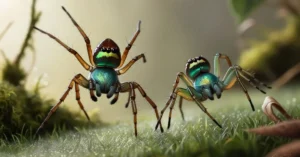Jumping spiders, belonging to the family Salticidae, are a captivating group of arachnids known for their exceptional hunting skills, vibrant coloration, and complex behavior. Unlike many spiders that rely on webs to catch their prey, jumping spiders are active hunters, utilizing their incredible agility and sharp vision to stalk and pounce on their prey. This article delves into the biology, behavior, and ecological significance of jumping spiders, exploring their unique adaptations and the role they play in various ecosystems.
Taxonomy and Diversity
Jumping spiders constitute the largest family of spiders, with over 6,000 described species spread across more than 600 genera. They are found in a wide range of habitats, from tropical rainforests to arid deserts, and are known for their remarkable ability to adapt to different environmental conditions. The family Salticidae is divided into several subfamilies, including Salticinae, Euophryinae, and Spartaeinae, each exhibiting distinct morphological and behavioral traits.
Morphological Characteristics
One of the most distinguishing features of jumping spiders is their eye arrangement. They possess four pairs of eyes, with the anterior median eyes (AME) being particularly large and forward-facing. These large eyes provide them with excellent binocular vision, crucial for judging distances when jumping. The other pairs of eyes, positioned on the sides and top of the head, give them a wide field of view, allowing them to detect movement and potential threats from various angles.
Jumping spiders are relatively small, with body lengths ranging from 1 to 25 millimeters, depending on the species. They have a compact, muscular body, which aids in their jumping ability. Their legs are strong and equipped with specialized hairs and claws that help them grip surfaces as they leap through the air.
The coloration of jumping spiders is another notable characteristic. Many species exhibit vibrant colors and intricate patterns, which can serve multiple purposes, such as camouflage, mating displays, or warning signals to potential predators. Some species are even capable of changing their color to match their surroundings, enhancing their ability to blend in with the environment.
Vision and Hunting Behavior
The vision of jumping spiders is among the best in the arachnid world, rivaling that of some vertebrates. Their large anterior median eyes provide acute vision, allowing them to detect prey from several centimeters away—a significant distance considering their small size. These eyes can move independently, enabling the spider to focus on different parts of its environment simultaneously.
Jumping spiders are active hunters that rely on their keen vision to stalk and capture prey. Unlike web-building spiders, which passively wait for prey to come to them, jumping spiders actively seek out their food. They primarily feed on insects and other small arthropods, but some species have been observed preying on vertebrates such as small lizards.
The hunting strategy of a jumping spider typically involves a combination of stealth and precision. Once the spider spots a potential prey item, it carefully approaches, using its excellent vision to judge the distance and plan its attack. When it is close enough, the spider leaps towards the prey with remarkable accuracy, capturing it with its front legs and delivering a quick, venomous bite to subdue it.
The jumping mechanism of these spiders is a fascinating subject of study. Unlike most animals that rely on muscle contractions for jumping, jumping spiders use a hydraulic system to power their leaps. They increase the blood pressure in their legs, causing them to extend rapidly and propel the spider forward. This method allows for precise control over the jump’s distance and direction, making them highly effective predators.
Mating and Reproductive Behavior

Jumping spiders exhibit complex and often elaborate courtship behaviors, particularly in species where males are vividly colored or possess distinctive physical features, such as enlarged chelicerae or specialized appendages. These displays are not only about attracting a mate but also about signaling the male’s fitness and reducing the likelihood of being mistaken for prey by the female.
During courtship, a male jumping spider will perform a series of visual and vibrational displays to capture the attention of a female. These displays can include intricate dances, leg waving, body vibrations, and even the production of sounds or tapping signals. The female evaluates the male’s performance and, if impressed, allows him to approach and mate.
Mating in jumping spiders is a delicate process, as the male must avoid being eaten by the female, who is often larger and more aggressive. To reduce the risk, the male may continue his courtship displays during the mating process, keeping the female calm and distracted.
After mating, the female lays her eggs in a silk sac, which she carefully guards until the spiderlings hatch. Depending on the species, a female may lay several egg sacs over her lifetime. The spiderlings undergo several molts as they grow, eventually leaving the safety of the maternal web to begin hunting on their own.
Communication and Social Behavior
While jumping spiders are generally solitary creatures, they possess a surprisingly sophisticated means of communication, primarily through visual signals. Given their reliance on vision, much of their communication involves body language and visual displays, which are crucial during courtship, territorial disputes, and predator avoidance.
In addition to visual communication, some jumping spiders also use vibratory signals to communicate. These signals are often transmitted through the substrate, such as the leaves or branches they are standing on, and can play a role in both mating and territorial behavior. For instance, a male spider may produce vibrations by drumming its legs or abdomen against the substrate, signaling its presence to a potential mate or rival.
Despite their solitary nature, certain species of jumping spiders exhibit social behavior, particularly during the juvenile stage. In some cases, siblings may remain together for a short period after hatching, sharing food and protection. However, as they mature, they typically disperse and become solitary hunters.
Ecological Role and Adaptations
Jumping spiders play a vital role in their ecosystems as both predators and prey. As active hunters, they help control populations of insects and other arthropods, contributing to the balance of their habitats. Their predatory behavior also makes them important biological control agents in agricultural settings, where they can help manage pest populations.
Adaptability is one of the key factors contributing to the success of jumping spiders. They are found in diverse environments, from tropical forests and grasslands to deserts and urban areas. Their ability to thrive in various habitats is partly due to their flexible diet and hunting strategies, as well as their tolerance for different climatic conditions.
In addition to their hunting prowess, some jumping spiders have evolved remarkable adaptations for survival. For example, the species Evarcha culicivora, found in East Africa, has developed a preference for mosquitoes that have recently fed on blood. This unique dietary habit provides the spider with a direct source of nutrients, allowing it to thrive in its environment.
Another fascinating adaptation is the mimicry observed in some jumping spiders. Certain species have evolved to resemble ants, a form of Batesian mimicry that helps them avoid predators. These spiders not only imitate the appearance of ants but also mimic their behavior, such as moving in a jerky, ant-like manner. This resemblance can deter potential predators that avoid ants due to their aggressive nature and chemical defenses.
Jumping Spiders and Human Interaction
Jumping spiders are generally not harmful to humans, as their venom is not potent enough to cause serious harm. However, their presence in homes or gardens can be unsettling to some people. Despite this, they are beneficial to humans due to their role in controlling pest populations. In fact, many gardeners and farmers welcome jumping spiders for their natural pest control abilities.
The unique behaviors and vibrant appearances of jumping spiders have also made them popular among arachnid enthusiasts and researchers. Their relatively small size and non-aggressive nature make them suitable subjects for study in laboratory settings. Researchers have explored various aspects of their biology, including their vision, hunting strategies, and cognitive abilities, leading to a deeper understanding of arachnid behavior and evolution.
In recent years, jumping spiders have also gained attention in the field of biomimetics, where scientists study natural systems to inspire innovative designs and technologies. The spider’s hydraulic jumping mechanism, for instance, has been of particular interest to engineers developing advanced robotics and microfluidic systems.
Conservation and Future Research
While jumping spiders are not currently considered endangered, their habitats are increasingly threatened by human activities, such as deforestation, urbanization, and climate change. Habitat loss can have a significant impact on jumping spider populations, particularly for species with specialized habitat requirements.
Conservation efforts aimed at preserving biodiversity and natural habitats are essential for ensuring the continued survival of jumping spiders and other arachnids. Protecting their habitats not only benefits the spiders but also supports the broader ecosystems in which they live.
Future research on jumping spiders holds promise for further discoveries, particularly in the areas of neurobiology, behavior, and ecology. Understanding the cognitive abilities of these spiders, such as problem-solving and learning, could shed light on the evolution of intelligence in invertebrates. Additionally, studying the impact of environmental changes on jumping spider populations could provide insights into the broader effects of climate change on arthropods.
Conclusion
Jumping spiders are a remarkable group of arachnids, distinguished by their agility, vision, and complex behavior. Their role as active hunters, coupled with their ability to adapt to diverse environments, makes them a key component of many ecosystems. While often overlooked due to their small size, jumping spiders offer valuable insights into the natural world and have the potential to inspire technological advancements. As we continue to explore and understand these fascinating creatures, we gain not only a deeper appreciation for the intricacies of the natural world but also the knowledge needed to protect and preserve it for future generations.

